mybatis是一个持久层的框架,用java写的,简化了jdbc操作的很多细节,是开发者只需要关注sql语句本身,而无需关注注册驱动,创建等繁杂过程,它使用了ORM思想实现了结果集的封装
Object Releational Mappging 对象关系映射:
简单的说,就是把数据库和实体类及实体类的属性对应起来,让我们可以操作实体类就实现操作数据库表。
今天我们需要做到实体类的属性和数据库表的字段保持一致
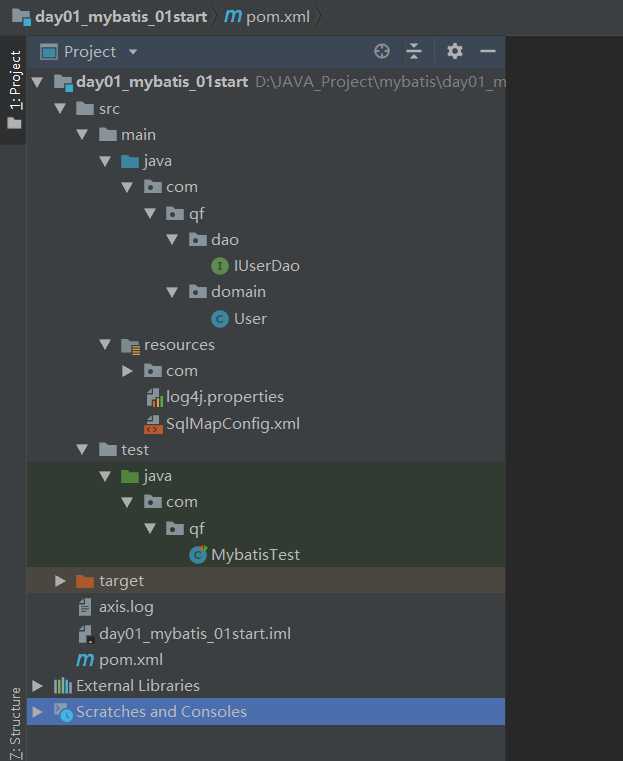
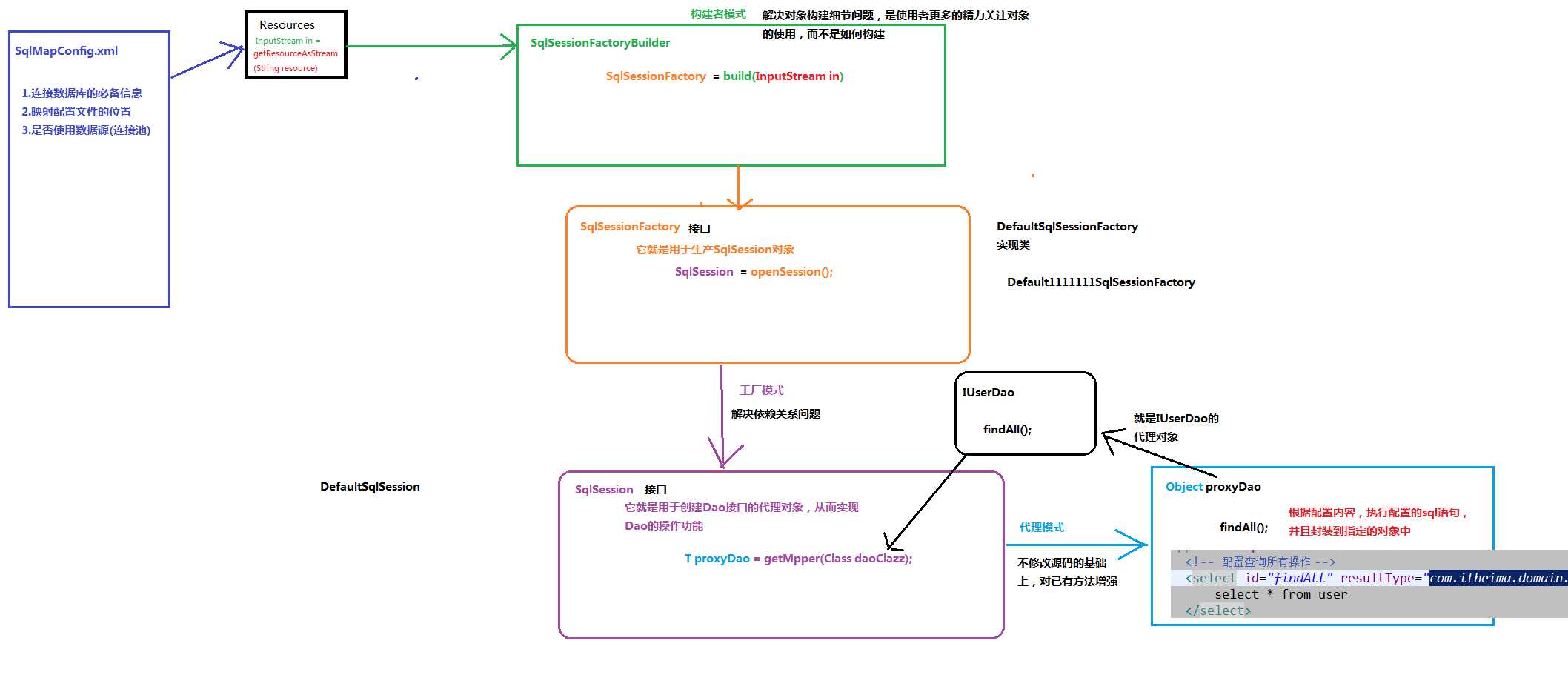
<dependencies>
<dependency>
<groupId>org.mybatis</groupId>
<artifactId>mybatis</artifactId>
<version>3.4.5</version>
</dependency>
<dependency>
<groupId>mysql</groupId>
<artifactId>mysql-connector-java</artifactId>
<version>5.1.32</version>
</dependency>
<dependency>
<groupId>log4j</groupId>
<artifactId>log4j</artifactId>
<version>1.2.17</version>
</dependency>
<dependency>
<groupId>junit</groupId>
<artifactId>junit</artifactId>
<version>4.12</version>
</dependency>
</dependencies>
import java.util.Date;
public class User implements Serializable {
private Integer id;
private String username;
private Date birthday;
private String sex;
private String address;
}
package com.github.domain;
/**
*
* 将所有的实体类封装到QueryVo中,将来执行dao的方法参数为实体类时,
* 只需要传递vo即可,实体类的属性通过OGNL表达式获取即可
*
* 使用
*
* @param
* @return
*/
public class QueryVo {
private User user;
public QueryVo(User user) {
this.user=user;
}
public User getUser() {
return user;
}
public void setUser(User user) {
this.user = user;
}
}
package com.github.dao;
import com.github.domain.QueryVo;
import com.github.domain.User;
import java.util.List;
/**
* @param
* @return
*/
public interface IUserDao {
/**
* 查询所有
* @return
*/
List<User> findAll();
/**
* 添加用户
* @param user
*/
int userSave(User user);
/**
* 更新用户
* @param user
*/
int updateUser(User user);
/**
* 根据id删除用户
* @param id 用户id
*/
int removeUser(Integer id);
/**
* 根据用户id查询用户信息
* @param userId 用户id
* @return
*/
User findById(int userId);
/**
* 根据用户名查询模糊用户
* @param username
* @return
*/
List<User> findByName(String username);
/**
* 查询总记录条数
* @return
*/
int findTotal();
/**
* 使用vo进行模糊查询
* @param vo
* @return
*/
List<User> findUserByVo(QueryVo vo);
}
使用mapper标签注册映射文件地址,使用resource属性指定注册映射文件位置
使用package的name属性注册指定的包下所有映射文件
<?xml version="1.0" encoding="UTF-8"?>
<!DOCTYPE configuration
PUBLIC "-//mybatis.org//DTD Config 3.0//EN"
"http://mybatis.org/dtd/mybatis-3-config.dtd">
<configuration>
<!-- 环境的配置 -->
<!--配置mysql的环境-->
<environments default="mysql"><!-- 选择使用id=mysql的 environment -->
<environment id="mysql">
<!--配置事务管理器-->
<transactionManager type="JDBC"></transactionManager>
<!--配置数据源-->
<dataSource type="POOLED">
<property name="driver" value="com.mysql.jdbc.Driver"></property>
<property name="url" value="jdbc:mysql://localhost:3306/eesy_mybatis"></property>
<property name="username" value="root"></property>
<property name="password" value="123"></property>
</dataSource>
</environment>
</environments>
<!--指定映射文件位置-->
<mappers>
<mapper resource="com/qf/dao/IUserDao.xml"></mapper>
<!--使用该标签后,注册指定的包下所有类-->
<!--<package name="com.github.dao"></package>-->
</mappers>
</configuration>
Object Graphic Navigation Language(对象 图 导航 语言)
通过对象中的取值方法获取数据,在写法上将get省略了
? 比如:我们获取用户名称的写法
? 类中的写法:user.getUsername( );
? OGNL表达式写法:#{user.username}
? mybatis中为什么能直接写username而不用user.呢?
? 因为在parameterType中提供了属性所属的类,所以此时不需要写对象名
作用:指定映射配置文件所对应的接口
属性:
? namespace:指定映射的接口,注意,一定要是接口的全限定类名
作用:执行查询的指定方法
属性:
? id:指定接口类要执行的方法
? parameterType:执行方法的参数类型的全限定类名,基本数据和String类型直接写名称,
? resultType:指定查询返回结果全限定类名
作用:执行增删改的指定方法,返回值为影响数据库的行数
属性
? id:指定接口类要执行的方法
? parameterType:执行方法的参数类型的全限定类名,基本数据和String类型直接写名称
使用selectKe标签
select last_insert_id() 返回的主键id会封装到插入对象中
模糊查询也可以使用以下方法:
<?xml version="1.0" encoding="UTF-8"?>
<!DOCTYPE mapper
PUBLIC "-//mybatis.org//DTD Config 3.0//EN"
"http://mybatis.org/dtd/mybatis-3-mapper.dtd">
<mapper namespace="com.github.dao.IUserDao">
<!--查询所有-->
<select id="findAll" resultType="com.github.domain.User">
select * from user
</select>
<!--保存用户-->
<insert id="userSave" parameterType="com.github.domain.User">
<!-- 插入数据后返回插入数据的id,
属性:keyColumn:数据库的主键 keyProperty:数据库实体类的对应的id resultType:主键的类型 order:返回的时期-->
<selectKey keyColumn="id" keyProperty="id" resultType="int" order="AFTER">
select last_insert_id()
</selectKey>
insert into user(username,birthday,sex,address) values(#{username},#{birthday},#{sex},#{address})
</insert>
<!--更新用户-->
<update id="updateUser" parameterType="com.github.domain.User">
update user set username=#{username},birthday=#{birthday},sex=#{sex},address=#{address} where id =#{id}
</update>
<!--根据id删除用户-->
<update id="removeUser" parameterType="int">
delete from user where id =#{id}
</update>
<!--根据id查询用户-->
<select id="findById" parameterType="int" resultType="com.github.domain.User">
select * from user where id =#{id}
</select>
<!--根据名称模糊查询用户-->
<select id="findByName" parameterType="String" resultType="com.github.domain.User">
select * from user where username like #{username}
</select>
<!--查询总记录条数-->
<select id="findTotal" resultType="int">
select count(*) from user
</select>
<!--使用pojo类型作为参数实现查询所有-->
<select id="findUserByVo" resultType="com.github.domain.User" parameterType="com.github.domain.QueryVo">
select * from user where username like #{user.username}
</select>
</mapper>
使用typeAliases配置该包下面的类默认设置别名为类名首字母小写,如果需要自定义名称可使用@Alias注解配置别名
Mybatis默认不会自动提交事务,需要手动提交事务
sqlSession.commit( );
Mybatis也可以设置默认自动提交事务
sqlSession.commit( true )
package com.github;
import com.github.dao.IUserDao;
import com.github.domain.QueryVo;
import com.github.domain.User;
import org.apache.ibatis.io.Resources;
import org.apache.ibatis.session.SqlSession;
import org.apache.ibatis.session.SqlSessionFactory;
import org.apache.ibatis.session.SqlSessionFactoryBuilder;
import org.junit.After;
import org.junit.Before;
import org.junit.Test;
import java.io.IOException;
import java.io.InputStream;
import java.util.Date;
import java.util.List;
/**
* @param
* @return
*/
public class TestMybatis {
private IUserDao dao = null;
private InputStream is = null;
private SqlSession sqlSession = null;
/**初始化方法
* @throws IOException
*/
@Before
public void init() throws IOException {
//1、加载配置文件SqlMapConfig.xml进内存
is = Resources.getResourceAsStream("SqlMapConfig.xml");
//2、创建SqlSessionFactoryBuild
SqlSessionFactoryBuilder builder = new SqlSessionFactoryBuilder();
//3、创建工厂类
//使用构建者模式 因为SqlSessionFactory是抽象类
// 不能直接创建 为了省略创建SqlSessionFactory的实类所带来的麻烦,mybatis提供构建者模式屏蔽这些繁琐的步骤
SqlSessionFactoryBuilder builder = new SqlSessionFactoryBuilder();
//4、使用工厂类生产sqlSession
sqlSession = factory.openSession();
//5、使用sqlSession创建dao代理对象
dao = sqlSession.getMapper(IUserDao.class);
}
/**关闭资源方法
* @throws IOException
*/
@After
public void after() throws IOException {
//提交事务
sqlSession.commit();
sqlSession.close();
is.close();
}
/**
* mybatis查询所有操作测试
*/
@Test
public void testFindAll() throws IOException {
List<User> users = dao.findAll();
for (User user : users) {
System.out.println(user);
}
}
/**
* mybatis保存操作测试,并封装添加后生成的主键的id到user对象
*/
@Test
public void testSaveUser(){
User user = new User();
user.setUsername("James");
user.setBirthday(new Date());
user.setSex("男");
user.setAddress("深圳市宝安区");
System.out.println("======保存前的user = " + user+"======");
int i = dao.userSave(user);
System.out.println("======保存后的user = " + user+"======");
}
/**
* mybatis更新测试
*/
@Test
public void testUpdate(){
User user = new User();
user.setId(60);
user.setUsername("test的账户");
user.setBirthday(new Date());
user.setAddress("更新后的地址");
user.setSex("男");
int i = dao.updateUser(user);
if(i == 1){
System.out.println("更新成功");
}else {
System.out.println("更新失败");
}
}
/**
* mybatis查询单个操作测试
*/
@Test
public void testDeleteById(){
int i = dao.removeUser(60);
if(i == 1){
System.out.println("删除成功");
}else {
System.out.println("删除失败");
}
}
/**
* mybatis查询单个操作测试
* @return
*/
@Test
public void testFindById(){
User user = dao.findById(62);
System.out.println("user = " + user);
}
/**
* mybatis模糊查询操作测试
* @return
*/
@Test
public void testFindByName(){
List<User> users = dao.findByName("%James%");
for (User user : users) {
System.out.println(user);
}
}
/**
* mybatis聚合函数操作
* @return
*/
@Test
public void testFindTotal(){
int total = dao.findTotal();
System.out.println(total);
}
/**
* 测试使用queryVo作为参数实现模查询
*/
@Test
public void testFindUserByVo(){
User user = new User();
user.setUsername("%James%");
QueryVo vo = neQueryVo(user);
List<User> users = dao.findUserByVo(vo);
for (User user1 : users) {
System.out.println(user1);
}
}
}
放在src/main/java下面的*.xml文件没有编译到classpath中,在pom.xml中添加依赖,一般是把mapper文件放到resources下面。
<build>
<!-- 通过这种方式可以设置java下面的*.xml文件编译到classpath下面-->
<resources>
<resource>
<directory>src/main/java</directory>
<includes>
<include>**/*.xml</include>
</includes>
</resource>
</resources>
</build>
public interface UserDao {
//使用原生参数绑定
public User selectUserByIdAndPwd(Integer id , String pwd);
}
<select id="selectUserByIdAndPwd" resultType="user">
SELECT * FROM t_users
WHERE id = #{arg0} AND password = #{arg1} <!--arg0 arg1 arg2 ...-->
</select>
<select id="selectUserByIdAndPwd" resultType="user">
SELECT * FROM t_users
WHERE id = #{param1} AND password = #{param2} <!--param1 param2 param3 ...-->
</select>
import org.apache.ibatis.annotations.Param; //引入注解
public interface UserDao {
//使用MyBatis提供的@Param进行参数绑定
public User selectUserByIdAndPwd(@Param("id") Integer id , @Param("pwd") String pwd);
}
<select id="selectUserByIdAndPwd" resultType="user">
SELECT * FROM t_users
WHERE id = #{id} AND password = #{pwd} <!-- 使用注解值 @Param("pwd") -->
</select>
public interface UserDao {
//添加Map进行参数绑定
public User selectUserByIdAndPwd_map(Map values);
}
Map values = new HashMap(); //测试类创建Map
values.put("myId",1); //自定义key,绑定参数
values.put("myPwd","123456");
User user = userDao.selectUserByIdAndPwd_map(values);
<select id="selectUserByIdAndPwd_map" resultType="user">
SELECT * FROM t_users
WHERE id = #{myId} AND password = #{myPwd} <!-- 通过key获得value -->
</select>
public interface UserDao {
//使用对象属性进行参数绑定
public User selectUserByUserInfo(User user);
}
<select id="selectUserByUserInfo" resultType="user">
SELECT * FROM t_users
WHERE id = #{id} AND password = #{password} <!-- #{id}取User对象的id属性值、#{password}同理 -->
</select>
MyBatis只能自动维护库表”列名“与”属性名“相同时的一一对应关系,二者不同时,无法自动ORM。

在SQL中使用 as 为查询字段添加列别名,以匹配属性名。
<mapper namespace="com.github.dao.IUserDao">
<select id="findAll" resultType=com.github.domain.User">
select id ad uid username as username birthday as userBirthday sex as userSex address ad userAddress from usre
</select>
</mapper>
使用ResultMap 标签
实体类的对象属性使用collection标签
在select标签中要使用reslutType属性指定ResultMap的id
public class User implements Serializable {
private Integer uid;
private String username;
private Date userBirthday;
private String userSex;
private String userAddress;
//todo get、set方法省略
}
<!--定义封装account和User的resultMap-->
<resultMap id="userMap" type="com.github.domain.User">
<!--一对一的关系映射,指定关联片段,并且封装user的内容 主键使用id标签 非主键使用result标签-->
<id column="id" property="uid"></id>
<result column="username" property="username"></result>
<result column="birthday" property="userBirthday"></result>
<result column="sex" property="userSex"></result>
<result column="address" property="userAddress"></result>
</resultMap>
<!--查询所有-->
<select id="findAll" resultMap="userMap">
select * from user
</select>
细节:关于时间类型的转换
如果数据库时间对应是deteTime类型的,在映射配置文件中的配置的
中对应的实体类属性配置javaType为java.sql.Timestamp类型
jdbc.properties文件 规范:尽量满足规范加上jdbc前缀加以区分
jdbc.driver=com.mysql.jdbc.Driver
jdbc.url=jdbc:mysql://localhost:3306/eesy_mybatis
jdbc.username=root
jdbc.password=123
Mybatis主配置文件使用${key}的形式从properties中取值
<?xml version="1.0" encoding="UTF-8"?>
<!DOCTYPE configuration
PUBLIC "-//mybatis.org//DTD Config 3.0//EN"
"http://mybatis.org/dtd/mybatis-3-config.dtd">
<!--Mybatis主配置文件-->
<configuration>
<!--使用properties配置mysql环境-->
<properties resource="jdbc.properties"></properties>
<!--环境配置-->
<environments default="mysql">
<environment id="mysql">
<!--配置事务管理器-->
<transactionManager type="jdbc"></transactionManager>
<!--配置数据源(连接池)-->
<dataSource type="POOLED">
<property name="driver" value="${jdbc.driver}"></property>
<property name="url" value="${jdbc.url}"></property>
<property name="username" value="${jdbc.username}"></property>
<property name="password" value="${jdbc.password}"></property>
</dataSource>
</environment>
</environments>
<mappers>
<package name="com.github.dao"></package>
</mappers>
</configuration>Mybatis中的连接池
配置的位置:
主配置文件SqlMapConfig.xml中的dataSource标签,type属性就是表示采用何种方式
type属性的取值:
POOLED(开发常用): 采用传统的javax.sql.DataSource规范的连接池,Mybatis中有针对规范的实现
UNPOOLDE:采用传统的获取连接方式,虽然也实现的javax.sqlDataSource接口,但是并没有使用连接池的思想
JNDI:采用服务器提供的JNDI技术实现,来获取DataSource对象,不同的服务器所能拿到的DataSou是不一样的 注意:如果不是web或者maven的war工程是不能使用的
作用:可以定义公共sql语句片段
属性:指定公共SQL语句的id,使用该片段使用include引入即可
<sql id="selectSql">
select * from user
</sql>
<!--应用SQL标签语句查询所有-->
<select id="findAll" resultMap="userMap">
<include refid="selectSql"/> where id = 45
</select>

作用:where标签会自动添加where关键字,去掉多余的and
作用:判断
属性:test test的值是参数中的值
<!--动态SQL语句进行模糊查询-->
<select id="findUserByCondition" resultMap="userMap" >
<!-- where标签会自动添加where关键字,去掉多余的and -->
<where>
<!--判断参数user的username属性是否为null 如果不为null则会自动拼接where语句 -->
<if test=" username != null and username!=‘‘">
and username = #{username}
</if>
<if test="userSex != null and userSex!=‘‘">
and sex=#{userSex}
</if>
</where>
</select>
/**
* 测试根据用户名和性别查询用户
*/
@Test
public void testFindUserByCondition(){
User user = new User();
user.setUsername("James");
user.setUserSex("女");
List<User> users = dao.findUserByCondition(user);
for (User user1 : users) {
System.out.println(user1);
}
}

作用:添加set关键字,去掉多余的逗号
<update id="updateUser" parameterType="user">
update user
<set>
<if test="username!=null and username!=‘‘">
username=#{username},
</if>
<if test="userBirthday!=null">
birthday=#{userBirthday},
</if>
<if test="userSex!=null and userSex!=‘‘">
sex=#{userSex},
</if>
<if test="userAddress!=null and userAddress!=‘‘">
address=#{userAddress},
</if>
</set>
<where>
<if test=" uid != null">
id = #{uid}
</if>
</where>
</update>
/**
* 测试更新用户
*/
@Test
public void testUpdateUser(){
User user = new User();
user.setUid(64);
user.setUsername("mybatis测试数据");
user.setUserSex("女");
user.setUserAddress("深圳市硅谷区");
user.setUserBirthday(new Date());
int i = dao.updateUser(user);
sqlSession.commit();
}

作用:用于循环集合或数组
属性:
? collection:循环的集合
? open:语句片段的开头,每次循环开始都会执行一次
? close:结束的语句片段,每次循环结束都会执行一次
? separator:每次都循环都执行片段
? item:每次遍历的对象,要保持和下面#{}内名字一至
/**
* 批量查询
* @param ids
* @return
*/
List<User> findByBatch(List<Integer> ids);
<!--使用foreach进行批量查询-->
<select id="findByBatch" parameterType="list" resultMap="userMap">
select * from user
<where>
<if test="list != null and list.size > 0">
<!-- 说明 collection:循环的集合
open:语句片段的开头 close:结束的语句片段 separator:每次都循环都执行片段
item:要保持和下面#{}内名字一至-->
<foreach collection="list" open="id in(" close=")" separator="," item="uid">
#{uid}
</foreach>
</if>
</where>
</select>

< trim prefix="" suffix="" prefixOverrides="" suffixOverrides="" >代替< where > 、< set >
<select id="selectBookByCondition" resultType="com.github.mybatis.day2.dynamic.Book">
SELECT id,name,author,publish,sort
FROM t_books
<trim prefix="WHERE" prefixOverrides="AND|OR"> <!-- 增加WHERE前缀,自动忽略前缀 -->
<if test="id != null">
and id = #{id}
</if>
<if test="name != null">
and name = #{name}
</if>
<if test="author != null">
and author = #{author}
</if>
<if test="publish != null">
and publish = #{publish}
</if>
<if test="sort != null">
and sort = #{sort}
</if>
</trim>
</select>
<update id="updateBookByCondition">
UPDATE t_books
<trim prefix="SET" suffixOverrides=","> <!-- 增加SET前缀,自动忽略后缀 -->
<if test="name != null">
name = #{name} ,
</if>
<if test="author != null">
author = #{author} ,
</if>
<if test="publish != null">
publish = #{publish} ,
</if>
<if test="sort != null">
sort = #{sort}
</if>
</trim>
WHERE id = #{id}
</update>
使用#进行查询()
DEBUG [main] - ==> Preparing: select ? from t_user
DEBUG [main] - ==> Parameters: id,username,age,email(String)
使用$进行查询
DEBUG [main] - ==> Preparing: select id,username,age,email from t_user
DEBUG [main] - ==> Parameters:
这种方式会出现SQL注入的问题,比较危险
两个符号的使用场景
1、#
? a)一般使用在参数的传递
? b)最后别解析为占位符的
2、$(危险,灵活)
? a)动态表的查询
表之间的关系有几种:
? 一对多、多对一、一对一、多对多
举例:
用户和订单就是一对多,订单和用户就是多对一,一个用户可以下多个订单、多个订单属于同一个用户人和身份证号就是一对一,一个人只能有一个身份证号,一个身份证号只能属于一个人老师和学生之间就是多对多,一个学生可以被多个老师教过,一个老师可以教多个学生.
特例:
如果拿出每一个订单,他都只能属于一个用户。所以Mybatis就把多对一看成了一对一。
作用:指定关系表的实体类型 指定多方关系时(集合)使用collection标签
属性:
? property:多的实体类属性名称
? ofType:多的实体类属性类型
作用:指定关系表的实体类型 指定一方关系时(对象属性)使用association标签
属性:
property:集合名称
javaType:多的一方的类型,这里也是支持别名
在查询一对多时,在对应实体类添加用于存放对应关系表实体类的集合属性
用户表 user

账户表 account
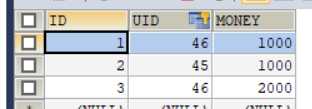
userDao接口
public interface IUserDao {
/**
* 查询所有
* @return
*/
List<User> findAll();
}
映射配置文件
<mapper namespace="com.github.dao.IUserDao">
<!--定义封装account和User的resultMap-->
<resultMap id="userMap" type="com.github.domain.User">
<!--一对一的关系映射,指定关联片段,并且封装user的内容 主键使用id标签 非主键使用result标签-->
<id column="id" property="uid"></id>
<result column="username" property="username"></result>
<result column="birthday" property="userBirthday"></result>
<result column="sex" property="userSex"></result>
<result column="address" property="userAddress"></result>
<!--指定关系表的实体类型 指定多方关系时(集合)使用collection标签 property:多的实体类属性名称 ofType:多的实体类属性类型 -->
<!--
配置对多
property:集合名称
ofType:多的一方的类型,这里也是支持别名
-->
<collection property="accounts" ofType="account">
<result column="aid" property="aid"></result>
<result column="uid" property="uid"></result>
<result column="money" property="money"></result>
</collection>
</resultMap>
<!--查询所有 一对多查询 多表连接查询-->
<select id="findAll" resultMap="userMap">
select *,u.id as uid,a.id as aid from user u left join account a on u.id = a.uid
</select>
</mapper>
usre实体类
public class User implements Serializable {
//user表与account表是一对多关系,需要添加List集合用于存储account
private Integer uid;
private String username;
private Date userBirthday;
private String userSex;
private String userAddress;
private List<Account> accounts;
//get set toString方法省略
}
account实体类
public class Account implements Serializable {
//account与user表是多对一的关系,添加User类型的属性
private Integer aid;//主键id
private Integer uid;//外键id
private Double money;//金额
private User user;
}
执行findAll()方法的结果

在多对一中,在多的实体类中添加一对应的实体类的属性(account实体类 和 user 实体类请参考7.2一对多查询)
IAccountDao接口
public interface IAccountDao {
/**
* 查询所有
* @return
*/
List<Account> findAll();
}
IAccountDao.xml映射配置文件
<mapper namespace="com.github.dao.IAccountDao">
<resultMap id="accountMap" type="account">
<id column="aid" property="aid"></id>
<result column="money" property="money"></result>
<result column="uid" property="uid"></result>
<!--
配置对多
property:集合名称
javaType:多的一方的类型,这里也是支持别名
-->
<association property="user" javaType="user" column="uid">
<id column="id" property="uid"></id>
<result column="username" property="username"></result>
<result column="birthday" property="userBirthday"></result>
<result column="sex" property="userSex"></result>
<result column="address" property="userAddress"></result>
<collection property="accounts" ofType="account">
<id column="aid" property="aid"></id>
<result column="money" property="money"></result>
<result column="uid" property="uid"></result>
</collection>
</association>
</resultMap>
<!--多对一查询 等价于一对一 使用多表连接查询-->
<select id="findAll" resultMap="accountMap">
select *,a.id as aid,u.id as uid from account a left join user as u on a.uid = u.id;
</select>
</mapper>
查询结果

在多对多查询中,需要借助第三张关系表进行关联
用户表uesr

角色表role

第三张关系表user_role
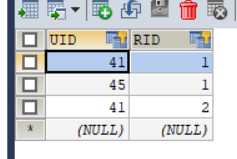
role表对应的实体类
public class Role implements Serializable {
private Integer rid;//角色id
private String roleName;//角色姓名
private String roleDesc;//角色描述
private List<User> users;
//get set toStirng 方法省略
}
IRoleDao接口
public interface IRoleDao {
/**
* 多对多查询所有
* @return
*/
List<Role> findAll();
}
IRoleDao的映射配置文件
<mapper namespace="com.github.dao.IRoleDao">
<resultMap id="roleMap" type="role">
<id column="id" property="rid"></id>
<result property="roleName" column="ROLE_NAME"></result>
<result property="roleDesc" column="ROLE_DESC"></result>
<collection property="users" ofType="user">
<id column="uid" property="uid"></id>
<result column="username" property="username"></result>
<result column="birthday" property="userBirthday"></result>
<result column="sex" property="userSex"></result>
<result column="address" property="userAddress"></result>
</collection>
</resultMap>
<select id="findAll" resultMap="roleMap">
select
r.*,u.*,u.id as uid
from
role r
left join
user_role ur
on
r.id = ur.rid
left join
user u
on
u.id = ur.uid
</select>
</mapper>
查询结果

缓存的重要性是不言而喻的。 使用缓存, 我们可以避免频繁的与数据库进行交互, 尤其是在查询越多、缓存命中率越高的情况下, 使用缓存对性能的提高更明显。
mybatis 也提供了对缓存的支持, 分为一级缓存和二级缓存。 但是在默认的情况下, 只开启一级缓存(一级缓存是对同一个 SqlSession 而言的)
同一个
SqlSession对象, 在参数和 SQL 完全一样的情况先, 只执行一次 SQL 语句(如果缓存没有过期)也就是只有在参数和 SQL 完全一样的情况下, 才会有这种情况。一级缓存的特点
1、一级缓存在SqlSession关闭或者提交的时候才会清空
2、MyBatis中的一级缓存默认是开启的
3、一级缓存只对SqlSession有效
测试一级缓存的存在
/**
* 测试一级缓存 一级缓存是因为是同一个sqlsession里面的,最终用的是同一个map作缓存,所以缓存取出的对象是同一个对象
*/
@Test
public void testFindUserById1() throws IOException {
InputStream is = Resources.getResourceAsStream("SqlMapConfig.xml");
SqlSessionFactory factory = new SqlSessionFactoryBuilder().build(is);
SqlSession sqlSession = factory.openSession();
IUserDao dao = sqlSession.getMapper(IUserDao.class);
User user = dao.findUserById(41);
System.out.println("----------------------");
System.out.println("第一次查询的user对象:"+user);
User user2 = dao.findUserById(41);
System.out.println("----------------------");
System.out.println("第二次查询的user对象:"+user2);
System.out.println(user == user2);
}

测试一级缓存的关闭
/**
* 测试一级缓存关闭
*/
@Test
public void testFindUserById2() throws IOException {
InputStream is = Resources.getResourceAsStream("SqlMapConfig.xml");
SqlSessionFactoryBuilder builder = new SqlSessionFactoryBuilder();
SqlSessionFactory build = builder.build(is);
SqlSession sqlSession = build.openSession();
IUserDao dao = sqlSession.getMapper(IUserDao.class);
User user = dao.findUserById(42);
System.out.println("第一次查询的user"+user);
//sqlSession关闭,一级缓存消失
sqlSession.close();
//创建新的sqlSession
SqlSession sqlSession1 = build.openSession();
IUserDao dao1 = sqlSession1.getMapper(IUserDao.class);
User user1 = dao1.findUserById(42);
System.out.println("第二次查询的user"+user1);
System.out.println(user == user1);
}

二级缓存的作用是整个Mapper,也可以说是整个SqlSessionFactory,域SqlSession无关,二级缓存的特点
? 1、二级缓存默认是关闭的,需要手动开启
? 2、二级缓存指的是SqlSessionFactory级别的,对所有的SQLSession共享
? 3、放入到二级缓存中的对象必须要实现对象序列化接口
? 4、如果要二级缓存有效必须要事务提交或者session关闭。
开启二级缓存需要的配置
? 1、在Mybatis的配置文件中添加setting属性
?
?
?? 2、需要在映射配置文件中添加
表示开启二级缓存 ? 3、catch属性:
* size:可以存放多个对象 * flushInterval:缓存刷新(清空)的时间,默认是不刷新,单位是毫秒
- readOnly:放在缓存中的对象是否只读
- a)如果是true,放进去的和获取到的是同一个对象
- b)如果是false,从缓存中获取到是这个对象的拷贝
- eviction:缓存清空的策略
- LRU:最少使用原则,移除最长时间不使用的对象,默认是LRU。
- FIFO:先进先出原则,按照对象进入缓存顺序进行回收
就是在需要用到数据时才进行加载,不需要用到数据时就不加载数据。延迟加载也称懒加载.
? 好处:先从单表查询,需要时再从关联表去关联查询,大大提高数据库性能,因为查询单表要比关联查询多张表速度要快。
? 坏处:
因为只有当需要用到数据时,才会进行数据库查询,这样在大批量数据查询时,因为查询工作也要消耗
时间,所以可能造成用户等待时间变长,造成用户体验下降。
我们需要在 Mybatis 的配置文件 SqlMapConfig.xml 文件中添加延迟加载的配置。
<setting name="lazyLoadingEnabled" value="true"/>
<setting name="aggressiveLazyLoading" value="false"/>
PageHelper是适用于MyBatis框架的一个分页插件,使用方式极为便捷,支持任何复杂的单表、多表分页查询操作。
PageHelper中提供了多个分页操作的静态方法入口。
pom.xml中引入PageHelper依赖。
<dependency>
<groupId>com.github.pagehelper</groupId>
<artifactId>pagehelper</artifactId>
<version>5.1.10</version>
</dependency>
在MyBatis-config.xml中添加< plugins >。
<configuration>
<typeAliases></typeAliases>
<plugins>
<!-- com.github.pagehelper为PageHelper类所在包名 -->
<plugin interceptor="com.github.pagehelper.PageInterceptor"></plugin>
</plugins>
<environments></environments>
</configuration>
使用PageHelper提供的静态方法设置分页查询条件。
/**
* 测试分页查询
*/
@Test
public void testFindUserByPage(){
IUserDao dao = sqlSession.getMapper(IUserDao.class);
//1、开启分页 pageNum:查询的页数,pageSize:每页的行数
PageHelper.startPage(2,3);
//2、查询当页的数据,参数mybatis会自动转换在sql语句内
List<User> userList = dao.findUserByPage();
//3、com.github.pagehelper.Page是继承List集合的
Page page = (Page) userList;
//4、创建PageInfo对象,并把page中的数据赋值给pageInfo
PageInfo<User> pageInfo = new PageInfo<User>(page);
System.out.println("当前页数:"+pageInfo.getPageNum());
System.out.println("每页的大小:"+pageInfo.getPageSize());
System.out.println("总页数:"+pageInfo.getPages());
System.out.println("总记录条数:"+pageInfo.getTotal());
System.out.println("分页数据集合:"+pageInfo.getList());
}
PageInfo对象中包含了分页操作中的所有相关数据。
| PageInfo结构图 |
|---|
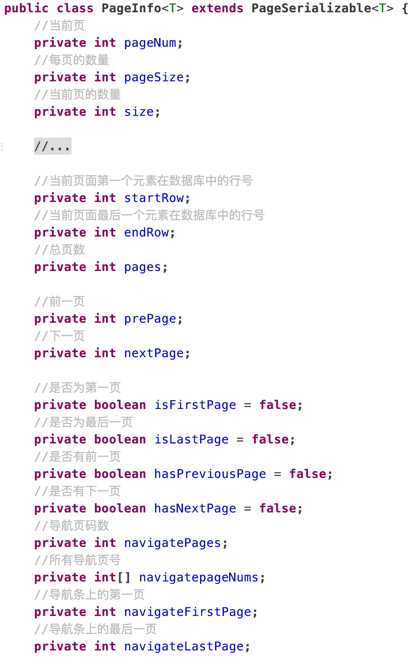 |

使用PageInfo保存分页查询结果。
@Test
public void testPageInfo(){
UserDao userDao = MyBatisUtils.getMapper(UserDao.class);
PageHelper.startPage(6, 2);
List<User> users = userDao.selectAllUsers();
PageInfo<User> pageInfo = new PageInfo<User>(users);//将分页查询的结果集保存在PageInfo对象中
System.out.println(pageInfo);
}
- 只有在PageHelper.startPage()方法之后的第一个查询会有执行分页。
- 分页插件不支持带有“for update”的查询语句。
- 分页插件不支持“嵌套查询”,会导致结果集折叠。
原文:https://www.cnblogs.com/codeli/p/13939566.html